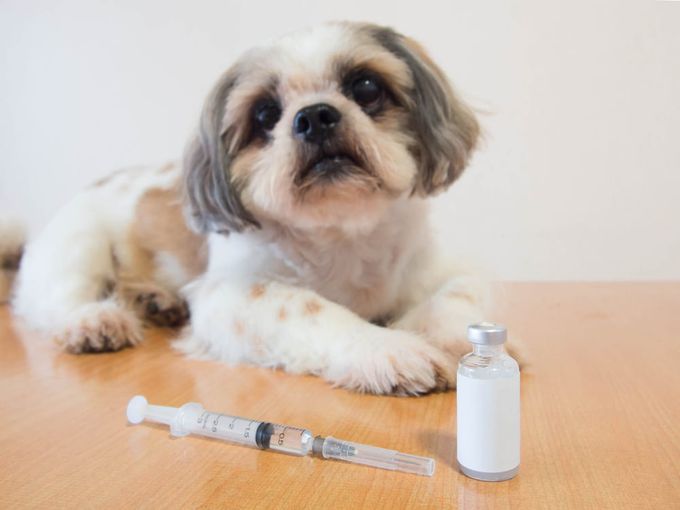Diabetes in Dogs: Common Risk Factors, Symptoms & Treatment
Have your dog's walks become shorter? Are high-energy games becoming a distant memory?
Published December 21, 2023.

Cases of diabetes in dogs have tripled in the last 30 years, according to recent research from PLOS ONE. What's behind the dramatic rise? A mix of genetic predispositions and environmental factors.
So, let's unravel the signs, reasons, and ways to diagnose and treat doggy diabetes.
🐾 Learn ways to help your dogs with separation anxiety
Types of Diabetes in Dogs
Diabetes Mellitus
Dogs with this type of diabetes can't use insulin properly, which causes sugar to build up in their blood. Treatment helps control it and keep your furry friend healthy.
Older dogs are more likely to get diabetes mellitus and should get regular vet checkups. The average age for diagnosis is about eight years, and it's uncommon to see this disease in pups under one.
Diabetes Insipidus
Imagine your dog goes to the bathroom constantly, even after just a short walk. They might also drink an unusual amount of water. This thirst could be a sign of diabetes insipidus, a rare condition affecting their ability to control urine production.
Note: Treatment for diabetes insipidus in dogs incorporates synthetic hormones to address excessive urine production.
Diabetic Ketoacidosis in Dogs
Since diabetic dogs can't use sugar properly, it builds up in their blood and triggers their body to burn fat for energy. This imbalance causes Ketoacidosis which produces harmful chemicals that can make them sick.
If left untreated, diabetic ketoacidosis can result in abnormal heart rhythms, compromised muscle function, or even death.
Indicators of Diabetic Ketoacidosis in Dogs
If your pet has ketoacidosis or poorly controlled diabetes, you may spot these symptoms:
- Depression
- Lethargy
- Anorexia
- Vomiting
Common Risk Factors for Diabetes in Dogs
Female pups tend to have an increased risk of diabetes and obesity, although it hasn't been yet confirmed. Research also shows that neutering male dogs can raise their chances of having these problems.
Additionally, dogs with existing health conditions like pancreatitis, high blood pressure, or infections are more likely to develop these issues as well. Long-term use of steroid medications can also be a contributing factor.
Dog Breeds Prone to Diabetes
Dogs of some breeds are more likely to get diabetes than others. In the UK, a recent study found that Border and West Highland White Terriers were prone to this condition.
Other breeds known to be at higher risk include:
- Cairn Terriers
- Miniature Schnauzers
- Poodles
- Bichon Frises
- Yorkshire Terriers
🐾 Discover dog breeds with the least health issues for new owners
Early Symptoms of Diabetes in Dogs
Dogs with diabetes show several signs:
- Thirsty and hungry all the time.
- Peeing way more than usual.
- Losing weight even though they eat more.
High blood sugar in dogs can also cloud their vision over time. It happens because glucose builds up in the lens, blurring it. Keeping their diabetes under control with proper monitoring and medication slows down this process and lowers the chance of cataracts.
Managing and Treating Diabetes in Dogs
Diabetic dogs need insulin shots for life. There are different kinds; your pup should get one or two daily. They go under the skin, and giving them exactly right is essential for managing their diabetes.
Nutrition
Choose special food for diabetic dogs that slow down how their body absorbs sugar. Fiber is especially helpful. You should also skip extra treats or scraps—they can add weight and worsen diabetes.
Pro Tip: Diabetic pups need mealtime like clockwork. Two meals a day, at the same time, help keep their blood sugar steady. It goes combined with their insulin shots for the best diabetes control.
Ongoing Monitoring
Regular vet checkups are critical. They'll track your pup's glucose levels and weight and adjust the diet if needed. You can help by checking their blood sugar at home if they seem off. It's just a tiny prick on the ear.
Pro Tip: Make blood sugar checks a happy time. After every test, encourage your pup and give them a yummy treat. They'll learn to love it, just like any other trick.
Regular Exercise
Exercise helps your dog fight diabetes. It keeps the blood sugar steady, improves the effectiveness of insulin, and prevents weight gain. Swimming—hydrotherapy—is a great, low-impact option, but it can be expensive because you need access to a pool. Regular walks or playtime work just as well.
Pet Insurance for Diabetic Dogs
Medication and veterinary care expenses can accumulate, becoming a significant factor in treatment. That's why investing in pet insurance before your dog gets ill is best.
Pet insurance, like Wagmo, can increase survival time for dogs dealing with diabetes. It acts as a safety net, so financial concerns don't hinder your ability to give your fur baby the necessary care.
Average Life Expectancy of Diabetic Dogs
A UK study revealed a mean survival time of eight months, fluctuating from 2 to 21. Meanwhile, another Italian research showed a mean survival time of up to 32.
Can dog diabetes be reversed?
Diabetes isn't reversible in dogs, but it can be managed successfully. There's promising research where scientists use collagen, a protein the body already makes for building muscles for non-invasive procedures.
🐾 Curious about insurance? Check out these important pet insurance considerations
Sweet Life, Tail Wags Guaranteed
Remember, a diabetic dog isn't a broken one but a pup with a special need. Dedication and proactive care can give your furry friend a happy, healthy life filled with tail wags.
DailyTails is your trusted companion on this journey. We believe every dog deserves a life brimming with joy and good health, regardless of dietary preferences or medical requirements.
Whether you're exploring top pet insurance providers or seeking advice on diet, behavior, and training, we're here to guide you through every facet of their holistic well-being.


